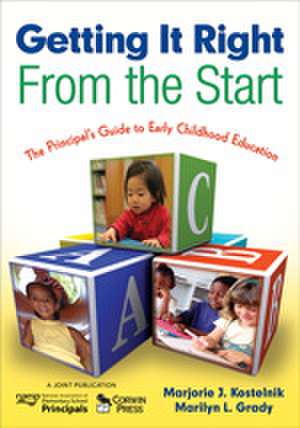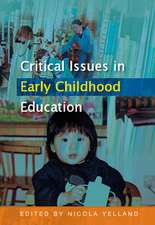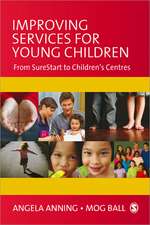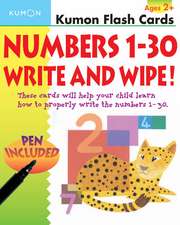Getting It Right From the Start: The Principal’s Guide to Early Childhood Education
Autor Marjorie J. Kostelnik, Marilyn L. Gradyen Limba Engleză Paperback – 2 iun 2009
Early Childhood Assessment Consortium, Council of Chief State School Officers
Prepare our youngest students for future learning success with effective ECE programs!
To ensure that young children are ready to enter kindergarten, elementary schools are becoming increasingly involved in early childhood education (ECE), and more and more principals have to deal with ECE issues. Now this practical manual shows principals what successful ECE programs look like—and how to achieve quality results in their schools and communities.
The authors provide an inside view of the field, touching on key areas of operation and discussing ways to avoid common pitfalls. Blending research-based content with practical applications, this accessible guide helps principals and other administrators:
- Gain a foundational understanding of how very young children learn
- Create quality environments and practices for teaching early learners
- Provide the kind of feedback staff need to improve
- Work successfully with ECE agencies and providers
- Easily implement the strategies outlined using reproducible forms, templates, and checklists
This comprehensive resource presents the information principals need to become key players in educating our nation's youngest learners!
Preț: 340.22 lei
Nou
Puncte Express: 510
Preț estimativ în valută:
65.11€ • 67.80$ • 55.03£
65.11€ • 67.80$ • 55.03£
Carte tipărită la comandă
Livrare economică 10-24 martie
Preluare comenzi: 021 569.72.76
Specificații
ISBN-13: 9781412949507
ISBN-10: 1412949505
Pagini: 344
Dimensiuni: 178 x 254 x 23 mm
Greutate: 0.7 kg
Ediția:1
Editura: SAGE Publications
Colecția Corwin
Locul publicării:Thousand Oaks, United States
ISBN-10: 1412949505
Pagini: 344
Dimensiuni: 178 x 254 x 23 mm
Greutate: 0.7 kg
Ediția:1
Editura: SAGE Publications
Colecția Corwin
Locul publicării:Thousand Oaks, United States
Recenzii
"In one relatively small volume, the authors have organized information on just about everything a school leader needs to get a well-designed program off the ground and to make sure it will get better as time goes on. A particular strength of the book is its effectiveness in defining the years of preschool through third grade as a cohesive unit within the school. This is especially evident in the extensive chapter on assessment. The book will have value for both current practitioners and those preparing to become elementary administrators."
"The day of preschool-aged children fully immersed in the public schools will be as common as kindergarten in the very near future. (And in many states, that day is here!) As principals prepare to embrace and successfully guide the addition of preschool children, families, and staff, they will need support and guidance in their new role as an early childhood/elementary principal. This book provides principals with exceptional support, guidance, and action plans to make their transition seamless."
“This book is a tremendous resource for principals. As a former elementary principal, I wish I could have had this book in my hands then to help me better understand and support the preschool classrooms in my building! This book will help principals better understand the components of learning through play, intentional design of classroom environments to foster learning, and the value of partnering with families.”
"Provides administrators with an easy-to-follow, detailed road map for a better understanding of early childhood education. For some quick information for the meeting, check out the Principal’s Role section. It is a superb resource, while the chapter provides the entire substance of developing the program."
"As a former principal, I was informed one year that I would open four 4-year-old classrooms in August of the next year. I understood developmentally appropriate practices and the abiding need to hire terrific early childhood teachers and teaching assistants. What I did not have in my toolbox were the structural components, such as how to create a daily schedule; how and where to provide for students' personal needs (eating, toileting, playing, transporting, etc.); and how to assess student progress and communicate effectively with parents. This guide would have supported my own learning and eased my sense of frustration in not providing adequate leadership for my team. This book offers school leaders a foundational resource of best practices and research that can support an immediate need."
"The day of preschool-aged children fully immersed in the public schools will be as common as kindergarten in the very near future. (And in many states, that day is here!) As principals prepare to embrace and successfully guide the addition of preschool children, families, and staff, they will need support and guidance in their new role as an early childhood/elementary principal. This book provides principals with exceptional support, guidance, and action plans to make their transition seamless."
“This book is a tremendous resource for principals. As a former elementary principal, I wish I could have had this book in my hands then to help me better understand and support the preschool classrooms in my building! This book will help principals better understand the components of learning through play, intentional design of classroom environments to foster learning, and the value of partnering with families.”
"Provides administrators with an easy-to-follow, detailed road map for a better understanding of early childhood education. For some quick information for the meeting, check out the Principal’s Role section. It is a superb resource, while the chapter provides the entire substance of developing the program."
"As a former principal, I was informed one year that I would open four 4-year-old classrooms in August of the next year. I understood developmentally appropriate practices and the abiding need to hire terrific early childhood teachers and teaching assistants. What I did not have in my toolbox were the structural components, such as how to create a daily schedule; how and where to provide for students' personal needs (eating, toileting, playing, transporting, etc.); and how to assess student progress and communicate effectively with parents. This guide would have supported my own learning and eased my sense of frustration in not providing adequate leadership for my team. This book offers school leaders a foundational resource of best practices and research that can support an immediate need."
Cuprins
Preface
About the Authors
1. Early Childhood Education: An Expanding Enterprise!
Increasing Family Demand
Early Learning Imperatives
Children at Risk of School Failure
Reducing the Achievement Gap: Starting Early
Early Childhood Education: A Sound Investment
Principals’ Roles: Laying the Groundwork
2. Quality Makes ALL the Difference
The Corrosive Impact of Poor Quality
High-Quality Defined
Leadership and High Quality
Becoming an Early Childhood Leader
Principals’ Roles: Achieving High Quality
3. Breaking New Ground: Getting Involved in Early Childhood Education
What Exactly Is Early Childhood Education?
Becoming Familiar With Early Childhood Culture
School Principals as Culture Brokers
Principals’ Roles: Getting Involved in Early Childhood Education
4. Early Childhood Education: Stakeholders
Identifying the Stakeholder
Collaboration
Give Voice to Stakeholders
Actions and Considerations
Principals’ Roles: Working With Stakeholders
5. Developmentally Appropriate Practice
Fundamental Principles of DAP
Developmentally Inappropriate Practice (DIP)
Applying DAP Requires Judgment
The Sounds of DAP!
Empirical Support for DAP
Common Questions About DAP
Principals’ Roles: Supporting DAP
6. The Principal’s Guide to How Young Children Develop and Learn
The Essential Nature of Young Children
How Young Children Develop
How Young Children Learn
What Children Are Learning
Principals’ Roles: Supporting Child Development and Learning
7. Early Childhood Curriculum
What Constitutes the Early Childhood Curriculum?
‘Goodness of Fit’ Between Early Education and Later Schooling
Implementing the Early Childhood Curriculum
Activities to Look for in Early Childhood Classrooms
Principal’s Roles: Curriculum
8. Learning Centers & Classroom Routines
Typical Learning Centers for Young Children
Skills Teachers Need to Run Effective Centers
How Classroom Routines Support Curricular Goals
A Typical Day for Children
Principals’ Roles: Centers and Routines
9. Early Childhood Assessment
Key Considerations
Authentic Assessment
Strategies to Guide Learning and Improve Instruction
Strategies for Identifying Children’s Special Needs
Assessing Early Childhood Programs and Learning Contexts
Pros and Cons of Standardized Assessment
The Principals’ Roles: Promoting Authentic Assessment
10. Early Childhood Education: Family Involvement
Through the Eyes of the Families
Looking Inside and Looking Outside
Suggestions for Families
Through the Eyes of Teachers
Parents Want Communication With the School
Family Roles
Principals’ Roles: Family Involvement
11. Early Childhood Teachers
Teachers Matter
The Critical Function of Principals
Characteristics of ‘Good’ Teachers
Formal Teacher Qualifications
Translating Teacher Standards Into Practice
Principals’ Roles: Supporting Early Childhood Teachers
12. Finding and Keeping Good Teachers
Shortage of Qualified Early Childhood Teachers
Looking for Teachers to Support Diverse Children and Families
Reducing Staff Turnover
Principals’ Roles: Hiring and Retaining Good Teachers
13. Physical Environments That Support Early Learning
Environmental Propositions
How Physical Environments Influence Child Development and Learning
Fundamentals of Environmental Planning
Physical Requirements of Activity-Based Instruction
Equipping Early Childhood Classrooms
The Great Outdoors!
Principals’ Roles: Creating Optimal Early Learning Environments
14. Early Childhood Education: Funding
Funding Sources
History of Federal Funding
State Funding
Local Funding
Start-Up Costs
Administrator Voices
Principals’ Roles: Funding
15. Action Summary
Tool A. Learning Center Checklist
Tool B. Key Instruments Used Nationally for Evaluation of Children in ECE Programs
Tool C. Daily Literacy Checklist P3
Tool D. Daily Numeracy Checklist P3
Tool E. Guidelines for Structuring Informative On-Site Observations
Tool F. Sample Interview Questions for Teacher Candidates
Tool G. Early Childhood Safety & Health Checklist
Tool H. Physical Requirements of Small Group Activity Centers
Tool I. ECE Classroom Equipment List
Tool J. Indoor Environment Checklist
References
Index
About the Authors
1. Early Childhood Education: An Expanding Enterprise!
Increasing Family Demand
Early Learning Imperatives
Children at Risk of School Failure
Reducing the Achievement Gap: Starting Early
Early Childhood Education: A Sound Investment
Principals’ Roles: Laying the Groundwork
2. Quality Makes ALL the Difference
The Corrosive Impact of Poor Quality
High-Quality Defined
Leadership and High Quality
Becoming an Early Childhood Leader
Principals’ Roles: Achieving High Quality
3. Breaking New Ground: Getting Involved in Early Childhood Education
What Exactly Is Early Childhood Education?
Becoming Familiar With Early Childhood Culture
School Principals as Culture Brokers
Principals’ Roles: Getting Involved in Early Childhood Education
4. Early Childhood Education: Stakeholders
Identifying the Stakeholder
Collaboration
Give Voice to Stakeholders
Actions and Considerations
Principals’ Roles: Working With Stakeholders
5. Developmentally Appropriate Practice
Fundamental Principles of DAP
Developmentally Inappropriate Practice (DIP)
Applying DAP Requires Judgment
The Sounds of DAP!
Empirical Support for DAP
Common Questions About DAP
Principals’ Roles: Supporting DAP
6. The Principal’s Guide to How Young Children Develop and Learn
The Essential Nature of Young Children
How Young Children Develop
How Young Children Learn
What Children Are Learning
Principals’ Roles: Supporting Child Development and Learning
7. Early Childhood Curriculum
What Constitutes the Early Childhood Curriculum?
‘Goodness of Fit’ Between Early Education and Later Schooling
Implementing the Early Childhood Curriculum
Activities to Look for in Early Childhood Classrooms
Principal’s Roles: Curriculum
8. Learning Centers & Classroom Routines
Typical Learning Centers for Young Children
Skills Teachers Need to Run Effective Centers
How Classroom Routines Support Curricular Goals
A Typical Day for Children
Principals’ Roles: Centers and Routines
9. Early Childhood Assessment
Key Considerations
Authentic Assessment
Strategies to Guide Learning and Improve Instruction
Strategies for Identifying Children’s Special Needs
Assessing Early Childhood Programs and Learning Contexts
Pros and Cons of Standardized Assessment
The Principals’ Roles: Promoting Authentic Assessment
10. Early Childhood Education: Family Involvement
Through the Eyes of the Families
Looking Inside and Looking Outside
Suggestions for Families
Through the Eyes of Teachers
Parents Want Communication With the School
Family Roles
Principals’ Roles: Family Involvement
11. Early Childhood Teachers
Teachers Matter
The Critical Function of Principals
Characteristics of ‘Good’ Teachers
Formal Teacher Qualifications
Translating Teacher Standards Into Practice
Principals’ Roles: Supporting Early Childhood Teachers
12. Finding and Keeping Good Teachers
Shortage of Qualified Early Childhood Teachers
Looking for Teachers to Support Diverse Children and Families
Reducing Staff Turnover
Principals’ Roles: Hiring and Retaining Good Teachers
13. Physical Environments That Support Early Learning
Environmental Propositions
How Physical Environments Influence Child Development and Learning
Fundamentals of Environmental Planning
Physical Requirements of Activity-Based Instruction
Equipping Early Childhood Classrooms
The Great Outdoors!
Principals’ Roles: Creating Optimal Early Learning Environments
14. Early Childhood Education: Funding
Funding Sources
History of Federal Funding
State Funding
Local Funding
Start-Up Costs
Administrator Voices
Principals’ Roles: Funding
15. Action Summary
Tool A. Learning Center Checklist
Tool B. Key Instruments Used Nationally for Evaluation of Children in ECE Programs
Tool C. Daily Literacy Checklist P3
Tool D. Daily Numeracy Checklist P3
Tool E. Guidelines for Structuring Informative On-Site Observations
Tool F. Sample Interview Questions for Teacher Candidates
Tool G. Early Childhood Safety & Health Checklist
Tool H. Physical Requirements of Small Group Activity Centers
Tool I. ECE Classroom Equipment List
Tool J. Indoor Environment Checklist
References
Index
Notă biografică
Marjorie J. Kostelnik began her career in early childhood education as a Head Start teacher and has been involved in educating children and teachers ever since. She was on the faculty at Michigan State for 22 years, serving 12 years as program supervisor of the Child Development Laboratories and then as chair of the Department of Family and Child Ecology. During her time in Michigan, she worked with early childhood educators in more than 100 programs developing curriculum, enhancing children¿s school readiness, and working with teachers to develop positive child guidance strategies. An author of 16 books, Kostelnik arrived at the University of NebraskäLincoln in 2001, where she is now serving as dean of the College of Education and Human Sciences. A former vice president of NAEYC, Kostelnik currently serves on the Lincoln Public Schools Community Learning Center Advisory Board and the State of Nebraska Early Childhood Interagency Coordinating Council. She received her master¿s degree and doctorate in human development and family studies from Penn State.
Descriere
From understanding how the youngest children learn to working with ECE agencies, this practical guide presents the information principals need to create effective early childhood education programs.











